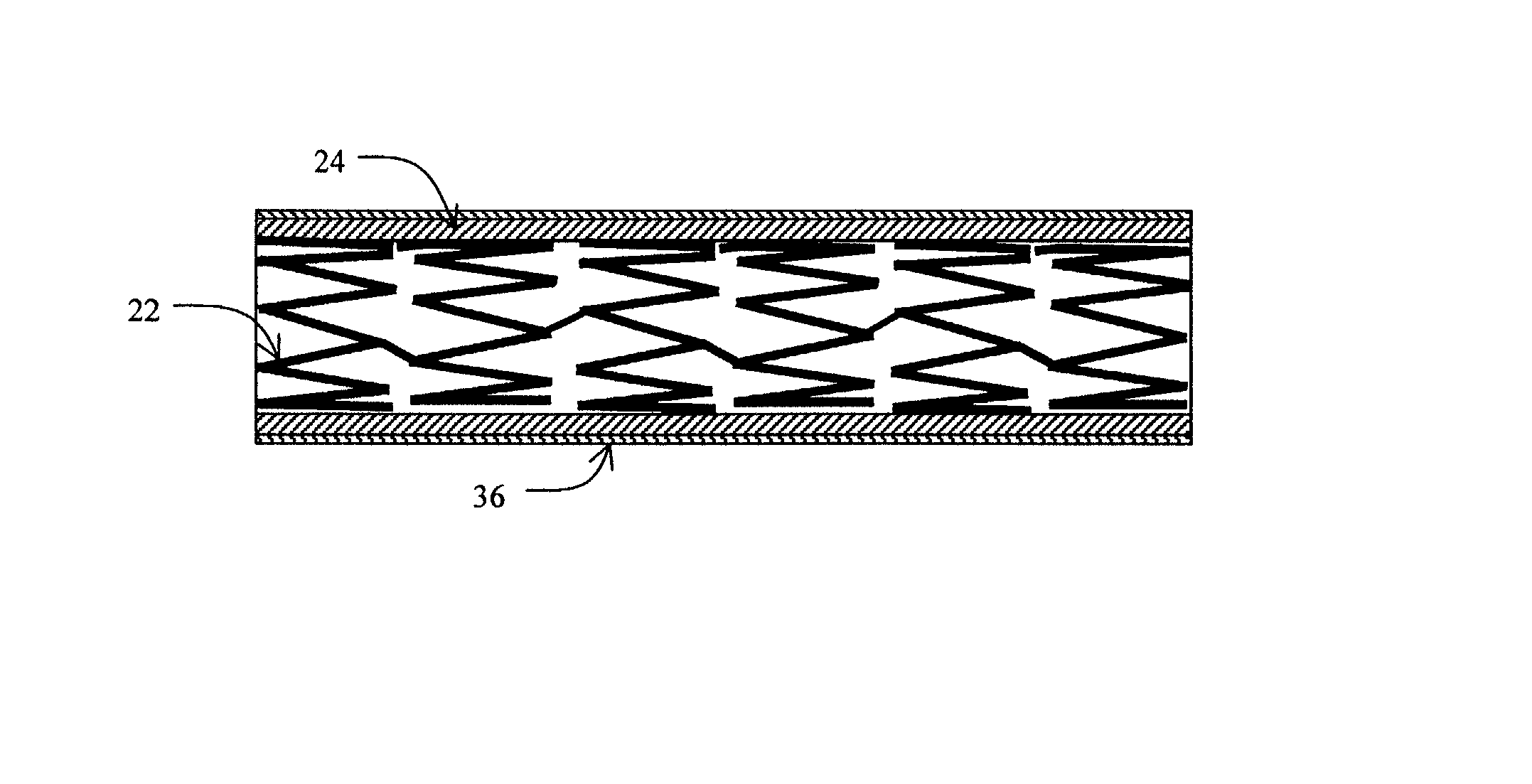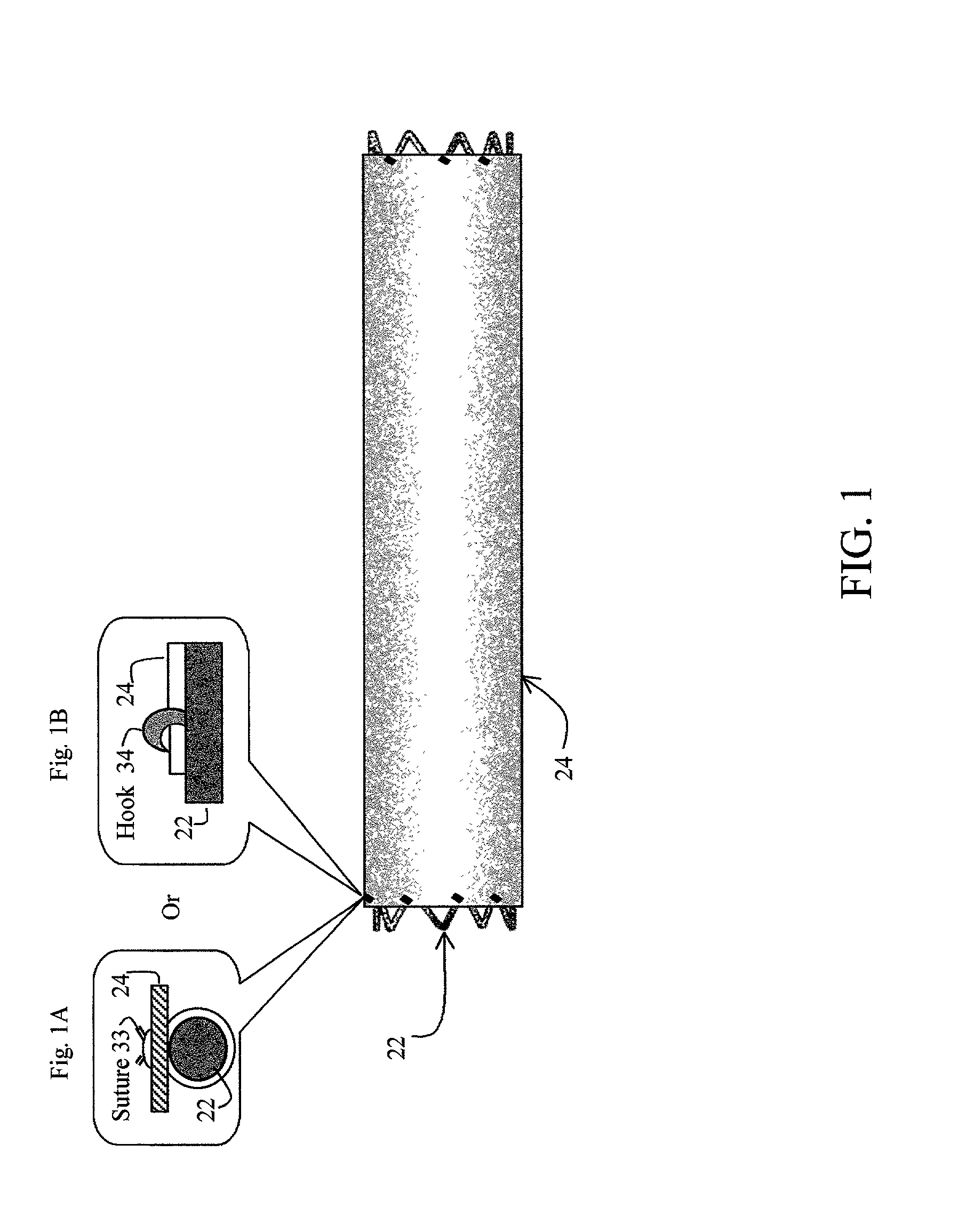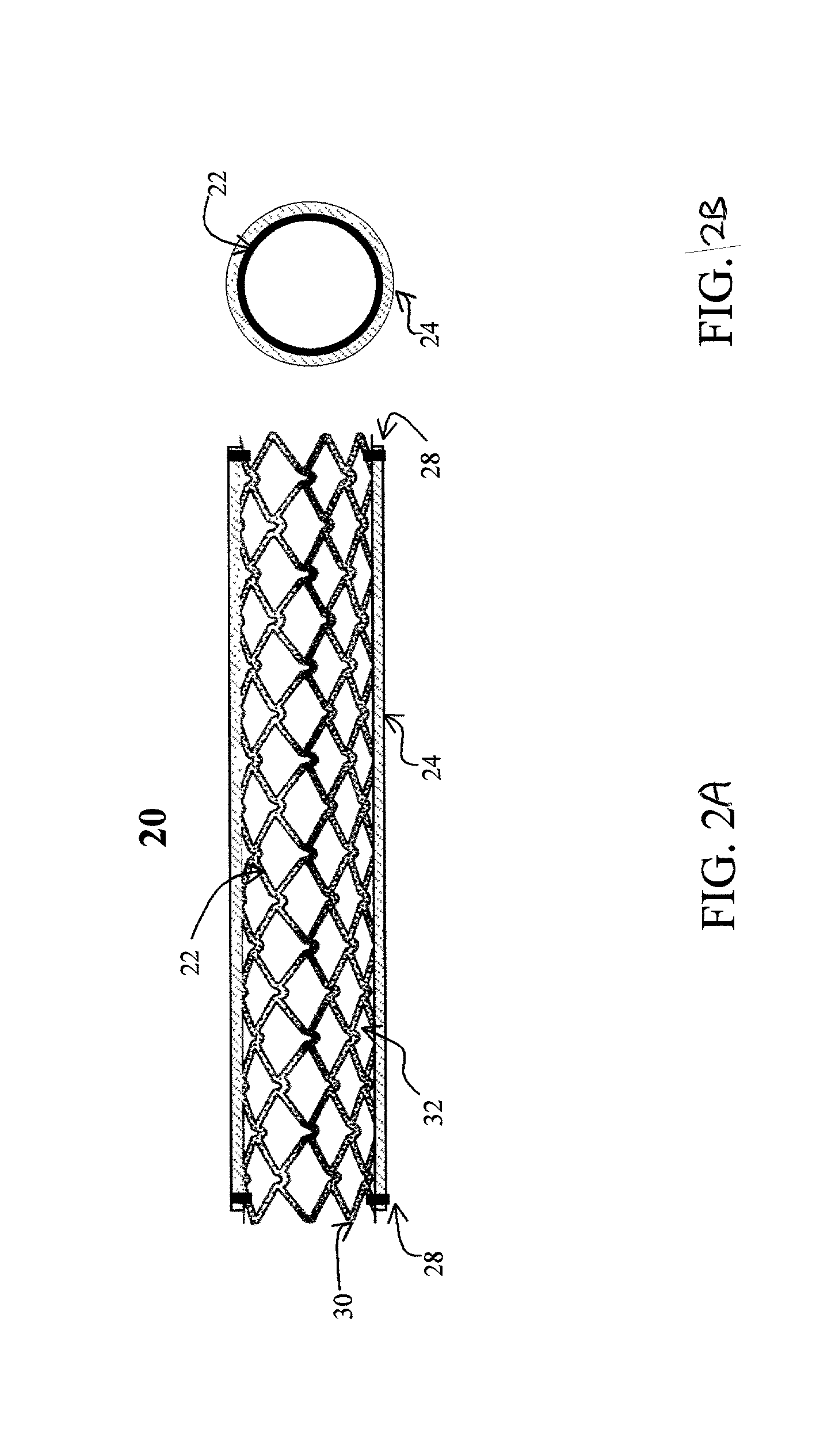Stent having cover with drug delivery capability
Inactive Publication Date: 2002-10-03
YANG JUN
View PDF0 Cites 34 Cited by
- Summary
- Abstract
- Description
- Claims
- Application Information
AI Technical Summary
Benefits of technology
[0015] It is an object of the present invention to provide an intraluminal prosthesis that minimizes or prevents the ingrowth of host tissue proliferation or inflammatory material through the interstices or ends of a stent.
[0026] The present invention provides an intraluminal prosthesis that has an underlying stent with a cover acting as a sheath or sleeve. The cover acts as a drug delivery device for locally delivering a drug to a vessel wall or lumen into which the prosthesis has been inserted and positioned. The cover also functions to block the path of cell migration (i.e., ingrowth), and to pave or act as a scaffold for supporting the lumen.
[0035] The cover 24 acts as a drug reservoir that stores the drug(s) to be released at the site of implantation of the prosthesis 20. The cover 24 is extensible (i.e., can be stretched) and flexible, and has the ability to absorb drugs and to store the drug(s) before the prosthesis 20 is deployed. The cover 24 can be either a single-layer of material (such as tissue or hydrogel) or multiple layers of material. When multiple layers are used, the layers can include (1) tissue with hydrogel layer, (2) polymer (non-drug loading) layer with hydrogel layer, (3) polymer (non-drug loading) layer with cultured tissue layer (e.g., culture collagen, elastin, crosslinked soluble protein, etc.), (4) hydrogel layer with hydrogel layer (e.g., two hydrogel layers having different drug release rates), and (5) polymer (non-drug loading) layer with tissue layer, among others. In the multiple-layer configuration, at least one material layer will absorb the drug, and one of the layers can be a non-drug loading layer. The non-drug loading layer would not contain any drug(s), and may be made of nonhydrogel polymers, such as polyurethanes, expanded PTFE, polyesters, polyamides, polylactide, polylactide-co-glycolide, polydioxanone, thermoplastic elastomers, thermoplastics, and silicone rubbers. The non-drug loading layer facilitates directional drug delivery since this layer forms a barrier against drug diffusion.
[0037] One method involves physical absorption into the cover 24. Under this method, the drug is loaded into the material during the rehydration process. The drug may be dissolved in a physiological solution for rehydration of the lyophilized material. If the drug has limited solubility in water, additional solvent may be added to facilitate the dissolving process, as long as the solvent has no adverse effects on the cover and the host patient. As an example, ethanol at a concentration of less than 50% v / v may be suitable for the rehydration process. The rehydration process for tissue and hydrogel is fast, easy and complete. The material has no noticeable change in property before dehydration and after complete rehydration. By changing the hydrophilicity of the material, the drug may be released at different rates.
Problems solved by technology
However, it has been found that restenosis can still occur with such stents in place.
In addition, a stent itself can cause undesirable local thrombosis.
As one example, these drugs can be delivered via oral, intravascular or intramuscular introduction, but these attempts have been largely unsuccessful.
Unfortunately, pills and injections are known to be ineffective modes of administration because constant drug delivery and higher local concentration are very difficult to achieve via these means.
Through repeated doses, these drugs often cycle through concentration peaks and valleys, resulting in time periods of toxicity and ineffectiveness.
However, the incorporation of drug into the walls or wires of the stent may significantly compromise the strength of the stent.
However, the loading in and releasing of drugs from a polymeric stent may change the structural integrity and mechanical properties of the stent.
Unfortunately, such polymer-coated stents have not been completely effective in preventing restenosis because of the cracking of the polymer as the stent is being expanded during deployment, saturation of the drug binding sites on the stent, and other reasons.
However, this approach suffers from the drawback that very few drugs are capable of being incorporated with common solid state polymers.
In addition, directional release of drug to either the lumen or the arterial wall cannot be achieved.
It will also be problematic for medical practitioners to select the type of drug and the dosage of the drug to be used, as well as the stent type to be implanted.
However, the stents do not prevent the ingrowth of the cancerous material through the interstices of the stent.
If the ingrowth reaches the inside of the stent, it might result in blockage of the body passageway in which the stent had been implanted.
In addition to the above-described problems experienced by localized drug delivery, conventional stents are also ineffective in preventing the ingrowth of host tissue proliferation or inflammatory material through the interstices of the stent.
Method used
the structure of the environmentally friendly knitted fabric provided by the present invention; figure 2 Flow chart of the yarn wrapping machine for environmentally friendly knitted fabrics and storage devices; image 3 Is the parameter map of the yarn covering machine
View moreImage
Smart Image Click on the blue labels to locate them in the text.
Smart ImageViewing Examples
Examples
Experimental program
Comparison scheme
Effect test
example 2
[0047] A polymeric stent cover, made of ePTFE, is provided with another layer of Taxol, gelatin, and poly(e-caprolactone) mixture (20:20:60) on the outside. 20% of the Taxol is released to the artery wall during the first week after implantation.
the structure of the environmentally friendly knitted fabric provided by the present invention; figure 2 Flow chart of the yarn wrapping machine for environmentally friendly knitted fabrics and storage devices; image 3 Is the parameter map of the yarn covering machine
Login to View More PUM
 Login to View More
Login to View More Abstract
A prosthesis has a cylindrical stent and a cover provided about the outer periphery of the stent. The cover can be made from a water absorbent material, and a matrix of protein. The cover can be made from either tissue or hydrogel.
Description
[0001] 1. Field of the Invention[0002] The present invention relates to prostheses for implantation into a mammalian vessel, and in particular, to intraluminal stents that are provided with a cover that can deliver and release drugs.[0003] 2. Description of the Prior Art[0004] The treatment of stenosis is the subject of much research and discussion. Stenosis are currently being treated by a number of well-known procedures, including balloon dilatation, stenting, ablation, atherectomy or laser treatment.[0005] Restenosis is the renarrowing of a peripheral or coronary artery after trauma to that artery caused by efforts to open a stenosed portion of the artery, such as by balloon dilatation, ablation, atherectomy or laser treatment of the artery. For such procedures, restenosis occurs at a rate of about 20-50% depending on the definition, vessel location, lesion length and a number of other morphological and clinical variables. Restenosis is believed to be a natural healing reaction t...
Claims
the structure of the environmentally friendly knitted fabric provided by the present invention; figure 2 Flow chart of the yarn wrapping machine for environmentally friendly knitted fabrics and storage devices; image 3 Is the parameter map of the yarn covering machine
Login to View More Application Information
Patent Timeline
 Login to View More
Login to View More IPC IPC(8): A61F2/00A61F2/06
CPCA61F2/07A61F2002/075A61F2230/0054A61F2/90A61F2250/0067
Inventor YANG, JUN
Owner YANG JUN
Features
- R&D
- Intellectual Property
- Life Sciences
- Materials
- Tech Scout
Why Patsnap Eureka
- Unparalleled Data Quality
- Higher Quality Content
- 60% Fewer Hallucinations
Social media
Patsnap Eureka Blog
Learn More Browse by: Latest US Patents, China's latest patents, Technical Efficacy Thesaurus, Application Domain, Technology Topic, Popular Technical Reports.
© 2025 PatSnap. All rights reserved.Legal|Privacy policy|Modern Slavery Act Transparency Statement|Sitemap|About US| Contact US: help@patsnap.com



